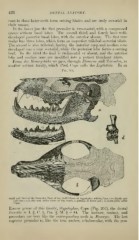Page 412 - My FlipBook
P. 412
422 DENTAL ANATOMY.
cone in these latter teeth form cutting blades and are truly sectorial in
their nature.
In the lower jaw the first premolar is t^vo-rooted, with a coni})ressed
crown without basal lobes. The second, third, and fourth have well-
developed posterior basal lobes, with the anterior al)sent. The first true
molar has three lobes, which form an imperfect trilobed sectorial blade.
The second is also trilobed, having the anterior cusp and median cone
developed into a true sectorial, while the posterior lobe forms a cutting
heel. In the third the heel is rudimental or absent, and the anterior
lobe and median cone are modified into a perfect trenchant blade.
From the Me^onychidce we pass, through Dissacus and Triitiodon, to
another extinct family, which Prof. Cope calls the Leptldidce. In an
Fig. 204.
Skull and Part of the Posterior Foot of two individuals of Shipulophvs whi/ice, Cope, two-thirds nat-
ural size: a, b, side and under views of the skull; c, portion of lower jaw,
Eocene genus of this family, Stj/poIopJms, Cope (Fig. 204), the dental
formula is I. f , C, \, Pm. ^, M. f = 44. The incisors, canines, and
premolars are very like the corresponding teeth in 3Iesonyx. The last
superior premolar is, like the true molars, tritubercular, with the pos-


